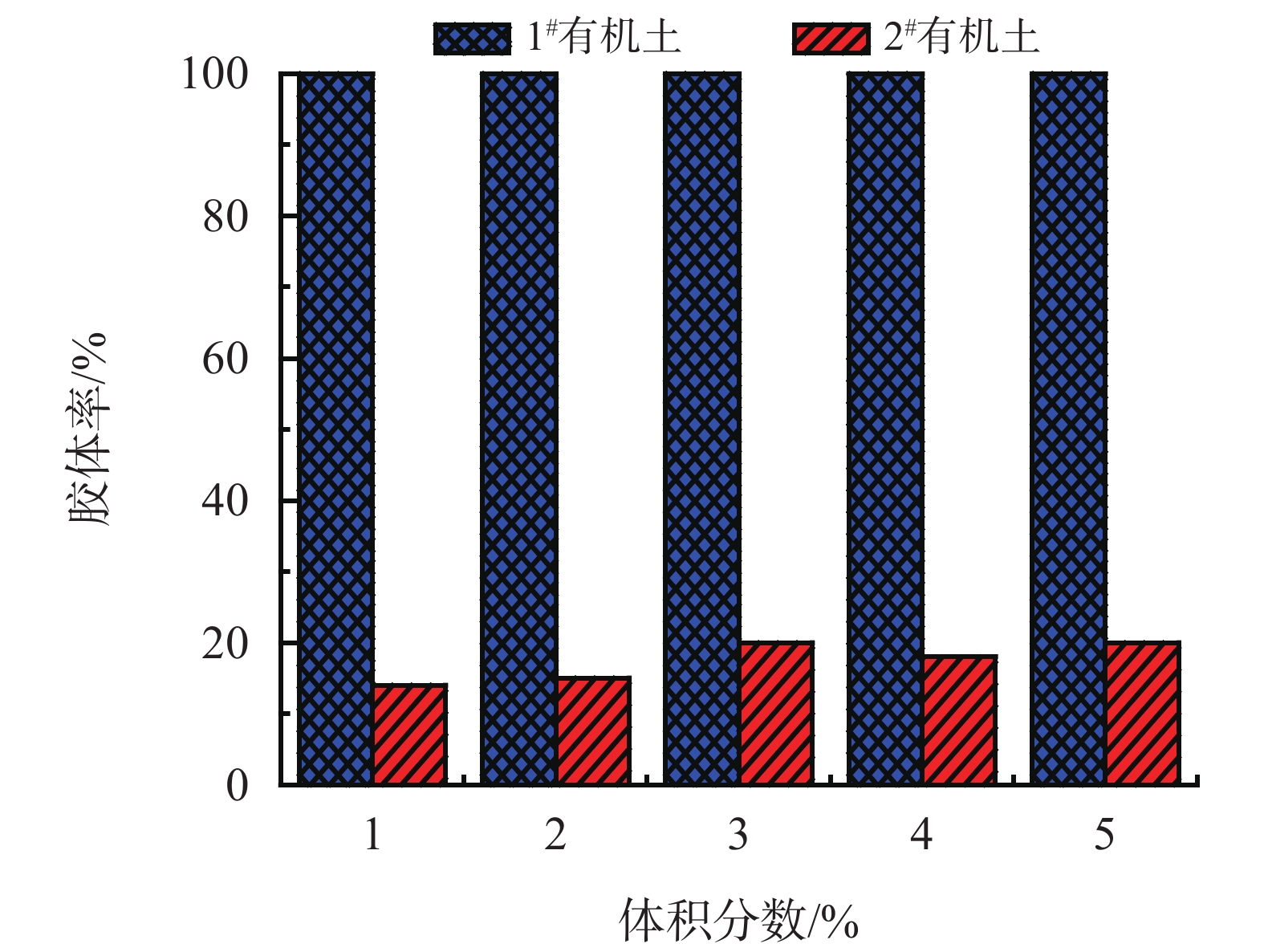Factors Affecting Colloid Fraction of Organophilic Clay Used in Oil Based Drilling Fluids
-
摘要: 针对不同生产工艺、不同类型的有机土在不同基础油中的胶体率差异较大的问题,分别对两个不同厂家的有机土(1#和2#有机土)进行胶体率实验。考察了不同类型的基础油、不同的极性溶剂(激活剂)和浓度、不同的搅拌速率、不同的搅拌时间对有机土胶体率的影响。结果显示:1#有机土在0#柴油中的胶体率100%,而在5#白油中的胶体率为20%,加入不同的极性溶剂胶体率达到100%;2#有机土在0#柴油、3#白油、5#白油中的胶体率均不足10%,加入极性溶剂后胶体率有不同程度的提高。此外,搅拌速率从3000 r/min增加至13 000 r/min,有机土胶体率从18%增加至29%;搅拌时间由5 min延长至40 min,有机土胶体率从22%增加至40%。通过实验数据分析,揭示了激活剂对有机土胶体率的作用机理,并对有机土胶体率性能指标的评价提出了建议,应明确测试条件,比如搅拌时间、搅拌速率、测试温度等,这些因素对有机土胶体率有一定的影响。Abstract: Two organophilic clay samples (1# and 2#) were taken to study the factors affecting the colloid fraction of the clays. Factors studied include type of base oil, type and concentration of polar solvent (activator), shear rate and time of shearing. It was found that the colloid fraction (expressed as percentage) of organophilic clay 1# was 100% in 0# diesel oil, and 20% in 5# diesel oil. When different polar solvents were added to the 5# diesel oil, the colloid fraction can be increased to 100%. The colloid fractions of the organophilic clay 2# in the 0#, 3# and 5# diesels were all less than 10%. After adding polar solvent in the three diesel oils, the colloid fractions of the organophilic clay in the three diesel oils were increased at different levels. When the stirring speed of the agitator was increased from 3000 r/min to 13,000 r/min, the colloid fractions of the organophilic clays were increased from 18% to 29%. When the time of shearing was increased from 5 min to 40 min, the colloid fractions of the organophilic clays were increased from 22% to 40%. Analysis of the experimental data has revealed the mechanism on which how activator affects the colloid fraction of organophilic clays. It is suggested in this paper that the conditions under which the colloid fraction test is performed should be specified, for example, the time of shearing, stirring speed and temperature etc. These factors also affect the colloid fraction of the organophilic clay.
-
Key words:
- Organophilic clay /
- Colloid fraction /
- Base oil /
- Activator /
- Stir
-
表 1 不同有机土在不同基础油中的胶体率
有机土 基础油 胶体率/% 1#有机土 3#白油 10 5#白油 20 0#柴油 100 2#有机土 3#白油 5 5#白油 5 0#柴油 8 注:有机土胶体率测试条件为室温,搅拌速率为
11 000 r/min, 搅拌时间为10 min表 2 极性溶剂介电常数与极性数据
极性溶剂 介电常数 极性 水 78.5 63.1 碳酸丙烯脂 65.0[12] 无水甲醇 32.7 55.5 无水乙醇 24.5 51.9 丙酮 20.7 42.2 -
[1] 曹杰,邱正松,徐加放,等. 有机土研究进展[J]. 钻井液与完井液,2012,29(3):81-84. doi: 10.3969/j.issn.1001-5620.2012.03.025CAO Jie, QIU Zhengsong, XU Jiafang, et al. Study progresses in organic clay[J]. Drilling Fluid & Completion Fluid, 2012, 29(3):81-84. doi: 10.3969/j.issn.1001-5620.2012.03.025 [2] Q/SY 1817—2015油基钻井液用有机土技术规范[S] .Q/SY1817—2015 Specifications of organophilic clay used in oil based drilling fluids[S]. [3] 付龙,潘一,杨双春. 白油基有机土室内性能评价[J]. 当代化工,2015,44(3):499-500. doi: 10.3969/j.issn.1671-0460.2015.03.021FU Long, PAN Yi, YANG Shuangchun. Performance evaluation on organic clay in white oil-based drilling fluids at laboratory[J]. Contemporary Chemical Industry, 2015, 44(3):499-500. doi: 10.3969/j.issn.1671-0460.2015.03.021 [4] 舒福昌, 向兴金, 史茂勇, 等. 白油中高成胶率有机土HMC-4的研究[J]. 石油天然气学报, 2013, 35(9): 93-95.SHU Fuchang, XIANG Xingjin, SHI Maoyong, et al. Study on organic clay HMC-4 with high colloid fraction in white oil[J].Journal of Oil and Gas Technology, 2013, 35(9): 93-95. [5] 王茂功,王奎才,李英敏,等. 柴油和白油钻井液用有机土性能研究[J]. 油田化学,2009,26(3):235-237.WANG Maogong, WANG Kuicai, LI Yingmin et al. Organic bentonite for use in diesel and mineral oil based drilling fluids[J]. Oilfield Chemistry, 2009, 26(3):235-237. [6] 崔明磊. 抗高温白油基钻井液用有机土的研制及性能研究[J]. 广州化工,2014,42(6):70-72. doi: 10.3969/j.issn.1001-9677.2014.06.026CUI Minglei. The development and testing of new organic clay with high temperature resistant ability in oil-based drilling fluid[J]. Guangzhou Chemical Industry, 2014, 42(6):70-72. doi: 10.3969/j.issn.1001-9677.2014.06.026 [7] 彭少贤,赵西坡,张燕,等. 新型超分散有机蒙脱石的制备和表征[J]. 硅酸盐通报,2009,28(1):58-62.PENG Shaoxian, ZHAO Xipo, ZHANG Yan, et al. Prepaaration and characterization of super dispersitic organa-montmorillonite[J]. Bulletin of the Chinese Ceramic Society, 2009, 28(1):58-62. [8] 骆小虎. 油基钻井液用有机土标准现状与探讨[J]. 钻井液与完井液,2020,37(5):566-571.LUO Xiaohu. Status and discussion of organoclay standars used in oil drilling fluid[J]. Drilling Fluid & Completion Fluid, 2020, 37(5):566-571. [9] 米远祝,黄志明,罗跃,等. 一种用于油基钻井液的有机土激活剂[J]. 科学技术与工程,2017,17(9):173-176. doi: 10.3969/j.issn.1671-1815.2017.09.030MI Yuanzhu, HUANG Zhiming, LUO Yue, et al. An organoclay activator for the oil-based drilling fluid[J]. Science Technology and Engineering, 2017, 17(9):173-176. doi: 10.3969/j.issn.1671-1815.2017.09.030 [10] 柳颖, 李建成, 关键, 等. 一种有机土激活剂及制备方法: CN, 102827589A[P]. 2012-12-19.LIU Ying, LI Jiancheng, GUAN Jian, et al. The invention relates to an organosol activator and a preparation method thereof: CN, 102827589A[P]. 2012-12-19. [11] 米远祝, 罗跃, 李建成. 一种油基钻井液有机土激活剂: CN, 103805147A[P]. 2014-05-21.MI Yuanzhu, LUO Yue, LI Jiancheng. The invention relates to an organic soil activator for oil base drilling fluid: CN, 103805147A[P]. 2014-05-21. [12] 张波,张立新. 碳酸丙烯酯含量对中间相炭微球负极材料电化学性能的影响[J]. 炭素技术,2018,37(1):15-19.ZHANG Bo, ZHANG Lixin. Effect of propylene carbonate content on the electrochemical performance of mesocarbon microbeads as negative electrode[J]. Carbon Techniques, 2018, 37(1):15-19. [13] KINJAL J S, MANISH K M, ATINDRA D S, et al. Controlling wettability and hydrophobicity of organoclays modified with quaternary ammonium surfactants[J]. Journal of colloid and interface science, 2013, 407:493-499. doi: 10.1016/j.jcis.2013.05.050 [14] HO D L, GLINKA C J. Effects of solvent solubility parameters on organoclay dispersions[J]. Chemistry of Materials, 2003, 15(6):1309-1312. doi: 10.1021/cm0217194 -





 下载:
下载:










